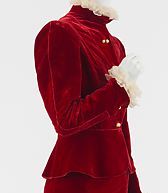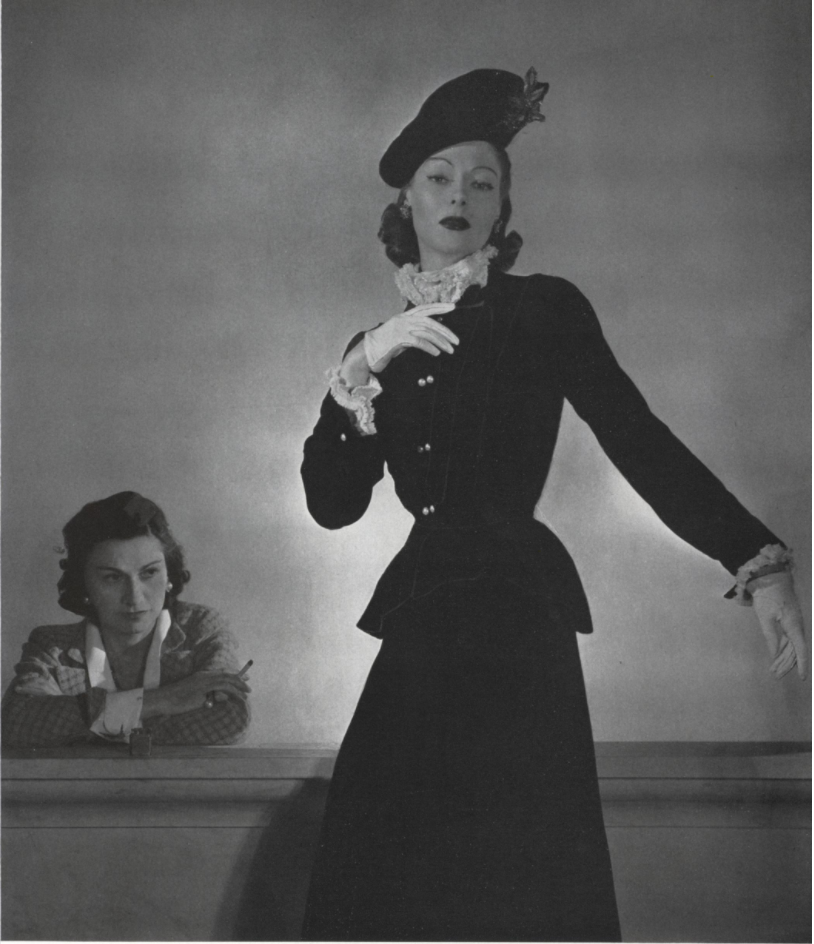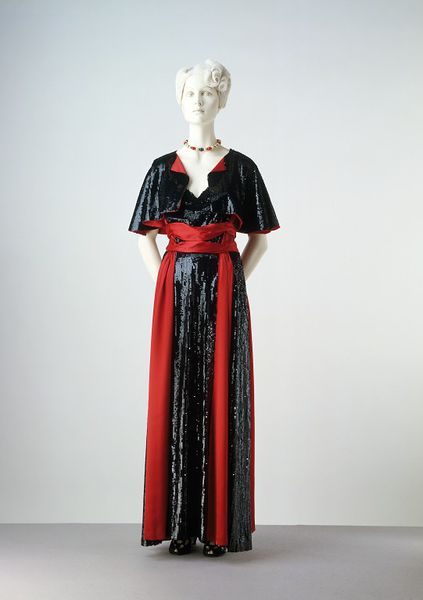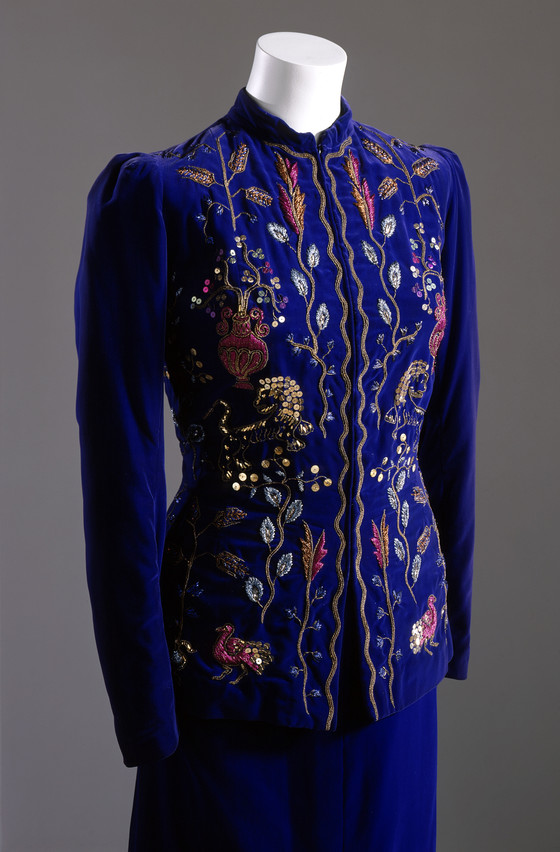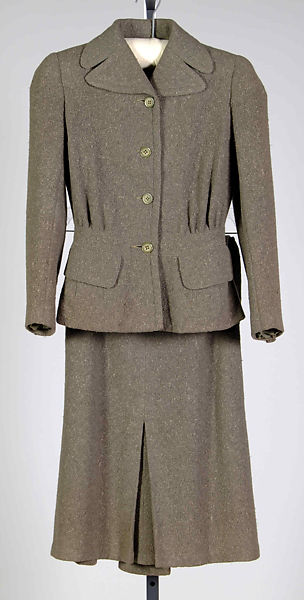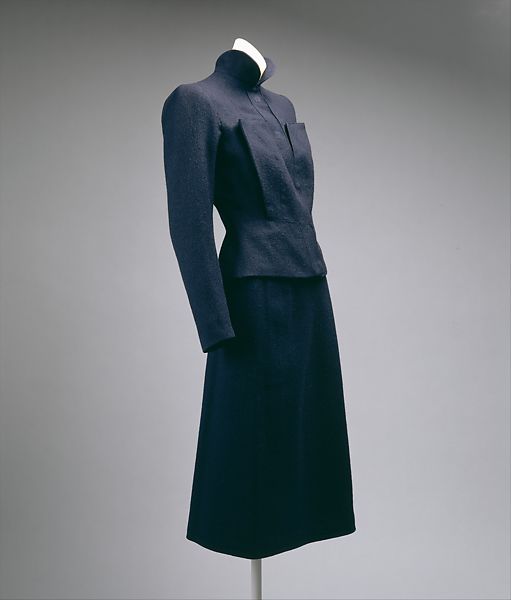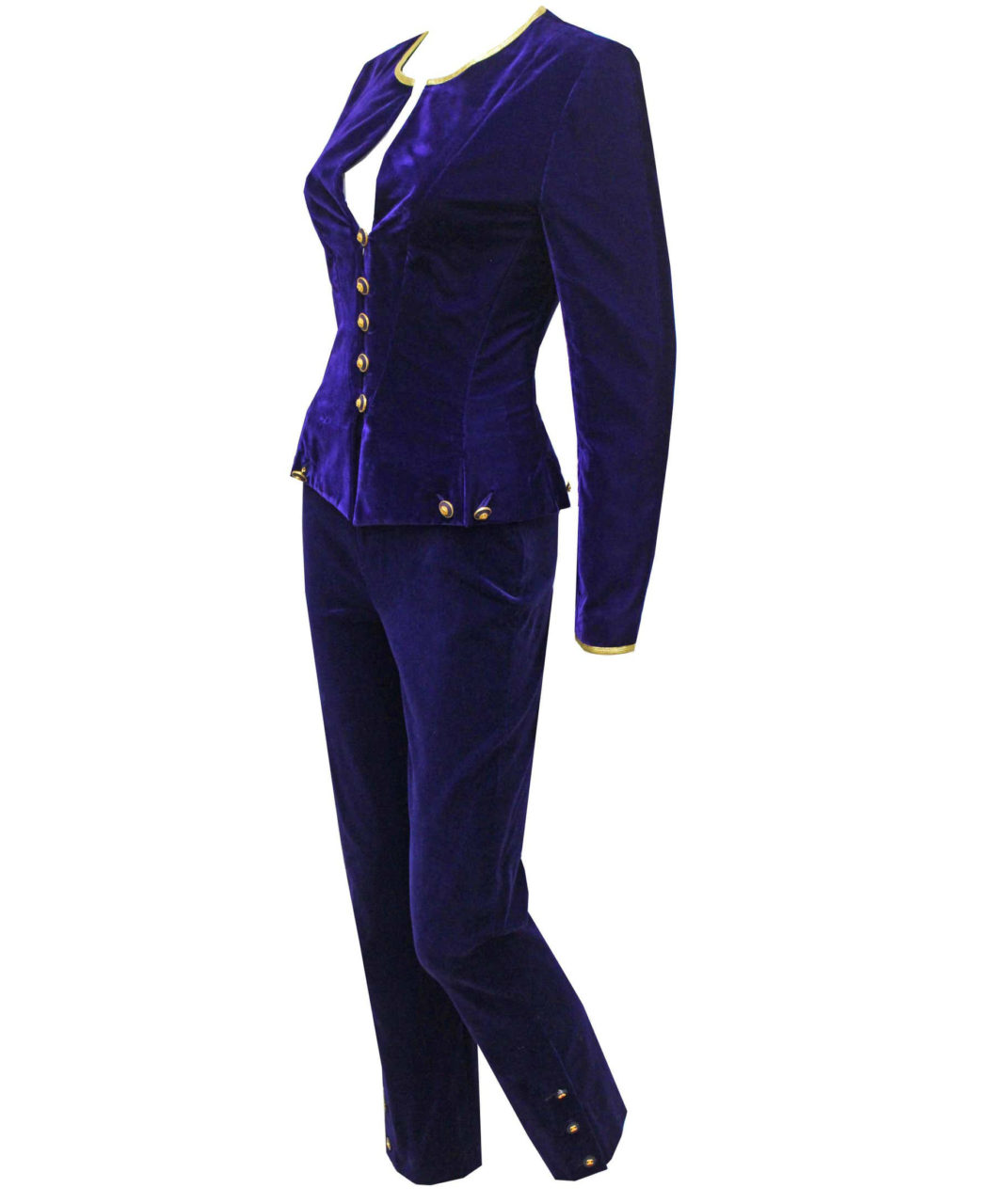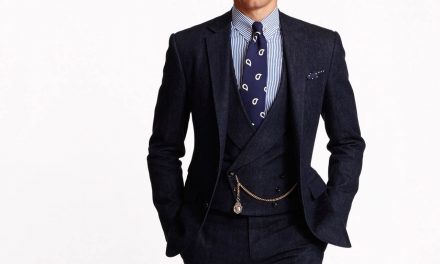This 1938 red silk velvet suit by Gabrielle Chanel is one of her more vibrant creations and part of a flamboyant trend in her work in the late 1930s.
About the Look
This velvet suit represents a departure from Gabrielle Chanel’s normal designs. It is a unique version of a black silk velvet suit she designed for winter 1938. The jacket is tight at the waistline and the skirt is medium length and hits below the knee, one of Chanel’s must-have elements of a suit. The waistline and the length of the skirt are very fashionable for the late 1930s. Unlike other women’s suits of this time, this one has a high, tight collar and white ruffles at the neckline and cuffs for a touch of history. It has gold buttons in the center of the blazer and the sleeves.
Fig. 1 - Gabrielle Chanel (France, 1883-1971). Suit, 1938. Silk. New York: Metropolitan Museum of Art, C.I.54.16.1a–d. Gift of Diana Vreeland, 1954. Source: MMA
Gabrielle ‘Coco’ Chanel (French, 1883-1971). Suit, Autumn/Winter 1938. Silk. New York: Metropolitan Museum of Art, C.I.54.16.1a–d. Source: MMA
About the context
Velvet was a hit in 1938.” Everyone likes the velvet touch,” claimed an article in the September 15, 1938 Vogue (62). Designers like Molyneux, Schiaparelli, and Balenciaga all produced velvet suits alongside Chanel for their winter season. What makes Chanel’s model stand out is the neck ruff, which was a special touch inspired by her experience at a historically-inspired masquerade ball (Vogue 62). Chanel’s suits were already well-known in the 1930s, but her favorite fabric was sensible wool jersey. Silk velvet was a departure from her normal style, but because she kept a simple cut this still strikes viewers as a Chanel design.
The Metropolitan Museum of Art describes her quintessential style, as seen in the 1937 suit in figure 2:
“Chanel’s most iconic design, immediately recognizable in its endless permutations, is her two- or three-piece suit… Soft and untailored, Chanel’s suits, often made from light, loosely woven tweed, exemplify her impulse toward ease and comfort. [They] facilitate movement [and] reveal practical details such as buttons with workable buttonholes and self-tie bows that suggest versatility within simplicity.”
The 1938 red velvet example was a special order; the suit that it was based on was a subtler black velvet (Fig. 3). In her book Chanel (2011), Amy de la Haye discusses the original suit:
“The publication of this seminal photograph in American Vogue (15 September 1939) coincided with the outbreak of war and marked the end of the boom era for Chanel and the haute couture industry. Maxwell models a black silk velvet suit with a white frilled neck ruff and cuffs, while Chanel looks on in the background. The ensemble, from Chanel’s ‘Watteau’ collection, can be interpreted as a precursor of Christian Dior’s 1947 ‘New Look’.” (45)
What De la Haye is referring to is the cinched waist and flared hips of the suit, which are more apparent in figure 3 than figure 1 because the model is wearing a corset and petticoat. This silhouette, which many designers were playing with in the late 30s, disappeared during World War II and was only brought back in the late 1940s, most famously by Dior.
Chanel, known for her ‘little black dress’ designs and practical suits, experimented with flashier fabrics in the late 1930s (Fig. 4), and followed the fashionable waistline instead of sticking to the boxier silhouettes she enjoyed in other decades.
Chanel did not favor striking colors for her suits. What makes this piece special and unique is that it was made for Diana Vreeland, who at the time worked for Harper’s Bazaar but eventually made a name for herself as the fantasy-loving Editor-in-Chief of Vogue in the sixties and then a special consultant for the Costume Institute at the Metropolitan Museum of Art in the eighties. Black, suitable for Madame Chanel, would have been too plain for Vreeland, who was famous for her vibrant style choices.
The Met explains Vreeland’s aesthetic:
“Like much of Mrs. Vreeland’s sensibility for fashion and style, the Watteau referencing of this Chanel suit was compelling part of its glamour. Art was important to Mrs. Vreeland, both as an editor and an exhibition impresario. She favored juxtapositions of art and contemporary fashion in the magazines and aligned art with fashion in her exhibitions. Chanel herself wore the same suit in black.”
In its October 15th, 1938 issue, American Vogue talked about autumn suits in Paris:
“The ‘little suit’ is eternal in Paris; and even in a season of frou-frou, femininity and fanfare, there are still serene and supremely wearable suits…” (112)
Chanel’s red velvet suit more closely resembles the more flavorful and surrealist designs of her contemporaries Nina Ricci and Elsa Schiaparelli, who played with velvet, loud pops of color, and embrodiery during this time (Fig. 5). In comparison, an American ready-to-wear suit by designer Bonnie Cashin is a practical, neutral color with pockets and without frills (Fig. 6). The Schiaparelli suit in figure 7 is an example of how a designer might play with shape and form while maintaining the appearance of a simple cut. Chanel rarely experimented with unusual construction in this way – her touches came out in fabric texture, buttons, and sometimes neckline adornments like the faux ruff (Fig. 1).
In The History of Modern Fashion (2015), Daniel James Cole and Nancy Deihl describe the House of Chanel in the 1930s, writing:
“Chanel’s was an individual aesthetic that, while keeping with the times, still followed themes present in her work since the beginning. Her jersey and woven suits, with belts cinching jackets at the waist, were still popular, as were her tennis clothes and beachwear.” (175)
Edmonde Charles-Roux explains Chanel’s attitude and essentials in his book The World of Coco Chanel (2006):
“It thus became essential that a skirt and jacket serve and, if possible, enough the movements and gestures of modern life: walking, running, sudden sitting down and getting up. She condemned without appeal and with utter ferocity anything that seemed to favor the taste of another time.” (366-367)
Coco Chanel did not produce any designs during the 1940s; the Second World War broke out shortly after her last 1939 collection and threw Paris into disarray (Young 145). While many fled the city, her affair with a Nazi officer allowed her to continue living comfortably at the Paris Ritz during this time. She did not design clothing again for fifteen years, and moved to Switzerland in 1945.
Chanel’s 1938 suit in red silk velvet for Diana Vreeland was on-trend for high fashion in 1938 in ways that her other suits were not, as practicality was always her guiding element. But her more exciting designs of the late 1930s paved the way for successors like Karl Lagerfeld, who created this purple velvet pantsuit for the House of Chanel more than sixty years later (Fig. 8).
Fig. 2 - Gabrielle 'Coco' Chanel (French, 1883-1971). Suit, 1937. Linen. New York: Metropolitan Museum of Art, C.I.54.16.2a, b. Gift of Diana Vreeland, 1954. Source: MMA
Fig. 3 - Gabrielle Chanel (French, 1883-1971). Velvet Touch in Paris, 1938. Silk velvet. Vogue (Sep 15, 1939). Source: ProQuest
Fig. 4 - Gabrielle Chanel (France, 1938-1971). Evening dress and cape, 1937-38. Silk satin and net embroidered with sequins, lined with satin. London: Victoria & Albert Museum, T.87&A-1974. Given by Mrs Leo d'Erlanger. Source: VAM
Fig. 5 - Nina Ricci (Italian (active France), 1883-1970). Woman's Suit (Jacket and Skirt), ca. 1938. Silk velvet with silk and metallic thread embroidery, metal strip embroidery, and plastic sequins; center back length of jacket: 65.72 cm (25 7/8 in). Los Angeles County Museum of Art, M.63.46a-b. Gift of Mrs. Albert E. Doerr. Source: LACMA
Fig. 6 - Bonnie Cashin (American, 1908-2000). Suit, 1938. Wool. New York: Metropolitan Museum of Art, 2009.300.6700a, b. Gift of Bonnie Cashin, 1951. Source: MMA
Fig. 7 - Elsa Schiaparelli (Italy, 1890-1973). Suit, Fall 1938. Wool. New York: Metropolitan Museum of Art, 1974.338.1a, b. Gift of Mrs. J.R. Keagy, 1974. Source: MMA
Fig. 8 - Karl Lagerfeld for Chanel (German (active France), 1933-2019). Exceptional Chanel purple velvet pant suit, Fall 1993, A/W 1993. London, LU1402983332. Source: 1stdibs
References:
-
Charles-Roux, Edmonde. The World of Coco Chanel: Friends, Fashion, Fame. London: Thames & Hudson, 2006. http://www.worldcat.org/oclc/1073375699
-
Cole, Daniel James, and Nancy Deihl. The History of Modern Fashion from 1850. London: Laurence King Publishing, 2015. http://www.worldcat.org/oclc/900012311
- De La Haye, Amy. Chanel: Couture and Industry. London: V & A Publishing, 2011. http://www.worldcat.org/oclc/764311281
- “Suit | 1937 | House of Chanel”, The Metropolitan Museum of Art, accessed May 14, 2020. https://www.metmuseum.org/art/collection/search/83554
- “Suit | 1938 | House of Chanel”, The Metropolitan Museum of Art, accessed September 16, 2019. https://www.metmuseum.org/art/collection/search/81131
- “Fashion: Paris Bids in Autumn Suits.” Vogue 92, no. 8 (October 15, 1938), 112. https://search.proquest.com/docview/879211466?accountid=27253
- “Fashion: Paris Openings–Variety show.” Vogue 94, no. 6 (September 15, 1939), 62. https://libproxy.fitsuny.edu:2818/docview/904289073?accountid=27253
- Young, Caroline. Living with Coco Chanel: The Homes and Landscapes that Shaped the Designer. Minneapolis: Quarto Publishing Group UK, 2019. http://www.worldcat.org/oclc/1112419257


